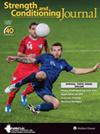Brief Review of Methods to Quantify High-Speed Running in Rugby League: Are Current Methods Appropriate?
IF 3
4区 医学
Q2 SPORT SCIENCES
引用次数: 2
Abstract
Supplemental Digital Content is Available in the Text. ABSTRACT High-speed running (HSR) has been documented within rugby league to differentiate playing standard and position and often precedes pivotal match events. Practitioners and researchers place importance on HSR because of its inclusion in assessing the demands of training and match play to help prescribe accurate training loads and recovery methods. HSR can be quantified in absolute terms whereby the same threshold speed is applied to all players (e.g., 5.0 m·s−1). Within rugby league, differences in tactical demand, anthropometric, and physical fitness characteristics exist between positions and players, suggesting that absolute HSR thresholds may not be appropriate because of underestimations and overestimations of HSR data. Alternatively, practitioners may individualize the threshold speed to individual players' physical qualities such as peak sprint speed, maximal aerobic speed (MAS), or the speed at which the ventilatory thresholds occur. Individualizing HSR warrants the practitioner to select a valid and practical test to quantify the HSR threshold speed. It is suggested that using peak sprint speed to quantify HSR can produce erroneous interpretation of HSR data while the practicality of specific physiological derived thresholds can be questioned. Implementing MAS to quantify HSR using a set time/distance trial may be the most appropriate approach for rugby league practitioners.橄榄球联盟高速跑量化方法综述:当前方法是否合适?
文本中提供了补充数字内容。摘要高速跑(HSR)在橄榄球联盟中已被记录在案,以区分比赛标准和位置,通常在关键比赛事件之前。从业者和研究人员重视HSR,因为它包含在评估训练和比赛需求中,有助于制定准确的训练负荷和恢复方法。HSR可以用绝对值来量化,从而将相同的阈值速度应用于所有玩家(例如,5.0 m·s−1)。在橄榄球联盟中,位置和球员之间存在战术需求、人体测量和身体素质特征的差异,这表明由于低估和高估了HSR数据,绝对的HSR阈值可能不合适。或者,练习者可以根据个别选手的身体素质来个性化阈值速度,例如峰值冲刺速度、最大有氧速度(MAS)或通气阈值出现的速度。个性化的HSR保证从业者选择一个有效和实用的测试来量化HSR阈值速度。有人认为,使用峰值冲刺速度来量化高铁可能会对高铁数据产生错误的解释,而特定生理衍生阈值的实用性可能会受到质疑。使用设定的时间/距离试验实施MAS来量化HSR可能是橄榄球联盟从业者最合适的方法。
本文章由计算机程序翻译,如有差异,请以英文原文为准。
求助全文
约1分钟内获得全文
求助全文
来源期刊

Strength and Conditioning Journal
社会科学-运动科学
CiteScore
4.70
自引率
8.00%
发文量
49
审稿时长
6-12 weeks
期刊介绍:
Strength and Conditioning Journal is the professional journal for strength coaches, personal trainers, physical therapists, athletic trainers, and other health professionals working in the strength and conditioning field. The journal’s mission is to publish articles that report both the practical applications of research findings and the knowledge gained by experienced professionals.
 求助内容:
求助内容: 应助结果提醒方式:
应助结果提醒方式:


